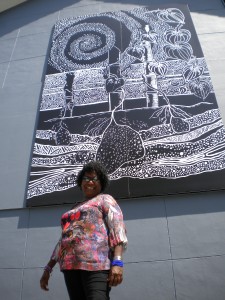
Going Global
- 2 Jul 2014
Vicki Salisbury from Umbrella Studio in Townsville shares her insights on what makes for successful international partnerships…
Every opportunity brings another opportunity as demonstrated by Umbrella’s long term relationship with James Cook University (JCU). Travelling to Asia last year to install Umbrella’s Compact Prints exhibition at JCU Singapore acquainted with me with key decision makers from JCU Singapore and the Australian High Commission who attended the opening. From the vantage point of being physically in front of decision makers, I proposed two projects: an exhibition for Townsville-based, Indigenous artist Gail Mabo for the annual NAIDOC 2014 celebrations at the Singapore High Commission; and a public art commission by Mabo for the University’s Singapore Campus.
 Umbrella’s intention is to reduce our reliance on Government funding, and partnerships are a key strategy. Umbrella has championed a social enterprise business model which aims to:
Umbrella’s intention is to reduce our reliance on Government funding, and partnerships are a key strategy. Umbrella has championed a social enterprise business model which aims to:
- Generate revenue and new opportunities
- Expand our reputation for quality and innovation
- Align Umbrella’s brand with peak agencies
- Apply commercial strategies to fortify the arts economy in North Queensland.
What are the critical success factors for partnerships?
Organisations must first determine what they aim to achieve from any partnership and identify stakeholders’ contribution to the process. Clarifying roles and responsibilities from the outset is the first step to viability.
Identifying stakeholders’ contribution and project timing went hand-in-hand as demonstrated by the launch of the exhibition and public artwork scheduled for the same week. Synchronising each element of the project enabled Umbrella to capitalise on funding from one partner to cover specific costs like exhibition freight and rely on funding and in-kind support from another partner for flights and accommodation. The cross-pollination of funds from each partner enabled both projects to be managed and delivered concurrently.
 What skills do arts organisations need to broker these relationships?
What skills do arts organisations need to broker these relationships?
The arts are good at galvanising innovative ideas because our relevance depends on performing outside the square. Using our well-honed skills of process documentation, distinctive sense of timing, familiarity of roles and responsibilities, we can ‘organically sense’ the recipe of a project’s potential. These collaborative partnerships emerged in the moment, out of a shared opportunity. I sensed opportunity because I was paying attention and was open to taking a calculated risk in order to move Umbrella forward.
What are the challenges?
The arts are comfortable communicating with diverse audiences because our jobs demand we report and deliver to manifold stakeholders. Maintaining the information loop so everyone is on the same page is essential. The impact of international time zones, language and cultural nuances and currency exchange rates are unanticipated variables to be considered. Another ongoing challenge was working through staff changes and changed priorities. My advice: document everything, even seemingly insignificant communication to minimise miscommunication and verify interactions.
Why did these partnerships work so well?
Umbrella and Gail Mabo have a solid, long-term relationship with JCU Townsville, utilised to expand networks into Asia. The intrinsic value, shared integrity and stakeholder expectations were aligned from the outset. In addition to generating revenue from art sales for Umbrella and the artist, both projects offered each stakeholder a smorgasbord of networking prospects and follow-up opportunities.
These high-level opportunities are usually the realm of fine art galleries operating internationally but Umbrella has boldly stepped into this sphere. Government and the private sector can assist us to identify and secure these kinds of big opportunities. Taking on new opportunities will open doors for Queensland artists and contribute to a bigger return on investment for funding bodies.
Vicki Salisbury
Mabo Kara Art at the Australian High Commission runs through 28 August 2014.
 Vicki was owner/manager of four successful fine art galleries in the US before moving to Australia in 1992 to complete a Masters in Anthropology at Monash. Her knowledge of Native American culture and arts steered her to develop an innovative project for World Vision Australia Indigenous Programs, which enabled micro-enterprise art projects in remote Indigenous communities throughout Australia. Following her role as ManagerVisual Arts and building the operational infrastructure for the Cultural Centre Townsville, Vicki transitioned to Umbrella Studio infusing the s2m key organisation with her passion and business experience.
Vicki was owner/manager of four successful fine art galleries in the US before moving to Australia in 1992 to complete a Masters in Anthropology at Monash. Her knowledge of Native American culture and arts steered her to develop an innovative project for World Vision Australia Indigenous Programs, which enabled micro-enterprise art projects in remote Indigenous communities throughout Australia. Following her role as ManagerVisual Arts and building the operational infrastructure for the Cultural Centre Townsville, Vicki transitioned to Umbrella Studio infusing the s2m key organisation with her passion and business experience.
Feature image: Gail Mabo speaking at the opening of the Mabo Kara Art exhibition in Singapore, with the Jawan Dancers. Image courtesy of the Australian High Commission Singapore.
Embedded images courtesy of Umbrella Studio: 1. Vicki Salisbury and Gail Mabo pointing out the Umbrella brand. 2. Gail Mabo with one of two public art works installed at JCU Singapore Campus – Ketai, Wild Yam.

